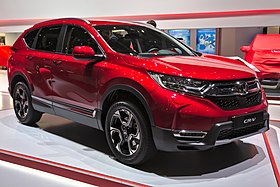THE EVOLUTION OF HONDA CRV
The Honda CR-V is a
compact crossover manufactured by Honda
since 1995 and introduced in the North American market in 1997.CR-V was
build on the Honda Civic Platform with a SUV body design,
CR-V stands for Compact Runabout Vehicle while the term
Compact Recreational Vehicle is used in a British car review article that was
republished by Honda.
In India the car that brought the crossover to the mainstream is perhaps
the Honda CR-V.The latest generation of the car will be launched in India
around Diwali
Lets have a look at the evolution of the Honda CR-V and its sales statistics .
Before the CR-V
In the 80's, Honda had toyed with the idea of a light
off-road vehicle. Called the Honda Civic Shuttle 4WD, it was essentially a
Civic with slightly raised ride height, larger mudflaps and, more importantly,
a four-wheel drive system. Its four-wheel drive mechanism was a particular
novelty. At the time, most 4WD mechanisms were mechanical which needed a lever
to engage the said mode. In the Civic Shuttle 4WD, a simple flick of the switch
engages the rear wheels and, later in its life, even gained a low-range
transmission.
By the late 80's, Honda introduced the second-generation
Civic Shuttle 4WD. Also known as the Beagle, it followed the formula of its
predecessor. Higher ground clearance, all-wheel drive and even underchassis
skid plates were part of the package. Honda probably knew they were on to
something at the time and set the precedent for one of Honda's most successful
models of all time.
With the experience gained from building the Civic Shuttle
4WD, Honda went on to develop their first, built from the ground-up SUV. With
its design finalized in 1993, the production model made its debut in Japan in
1995, a few months ahead of the car it was based on, the sixth-generation Civic
(EK). From its looks alone, this was no raised Civic wagon.
For starters, it came with a more advanced Realtime
All-wheel drive system which meant there was no longer the need for a switch to
send power to the rear wheels. Being based on the Civic, the CR-V got the
suspension goodies from it as well. It had double wishbone suspension on all
four corners, giving the first-generation CR-V a bit of dynamic flair. With a
2.0-liter engine under the hood, it initially had 126 PS but later gained 21
more horsepower for a total of 147 PS.
First Generation (1995-2001, RD1-RD3)
With the experience gained from building the Civic Shuttle
4WD, Honda went on to develop their first, built from the ground-up SUV. With
its design finalized in 1993, the production model made its debut in Japan in
1995, a few months ahead of the car it was based on, the sixth-generation Civic
(EK). From its looks alone, this was no raised Civic wagon.
For starters, it came with a more advanced Realtime
All-wheel drive system which meant there was no longer the need for a switch to
send power to the rear wheels. Being based on the Civic, the CR-V got the
suspension goodies from it as well. It had double wishbone suspension on all
four corners, giving the first-generation CR-V a bit of dynamic flair. With a
2.0-liter engine under the hood, it initially had 126 PS but later gained 21
more horsepower for a total of 147 PS.
. It practically opened the floodgates for 'Mini-SUVs' and
further broadened the appeal of the Honda brand . Also, who could forget the
built-in table which also served as the cargo area's floor?
Second Generation (2001-2006, RD4-RD9)
The new millennium saw an all-new Civic and, with that, an
all-new CR-V. The second-generation model saw several significant updates and
upgrades to the CR-V range. For its second iteration, the CR-V received an
all-new engine in the form of the K20 series. The new engine packed i-VTEC,
bringing variable valve timing to the CR-V for the first time. Also, the
second-generation CR-V lost the impressive (but expensive to produce) double
wishbone front suspension and in its place were a pair of struts.
The body also grew significantly from the first generation,
giving it more room inside. Honda even kept the novel picnic table from the
previous model.
When the facelift model was launched, it saw the return of
the all-wheel drive variant but this time, it had more power to boot. All-wheel
drive CR-Vs now came with a larger 2.4-liter i-VTEC engine with 160 PS and 220
Nm of torque. Over in Europe however, the CR-V received Honda's first-ever
in-house diesel engine: the i-CDTi. The 2.2-liter mill produced 150 PS and 350
Nm of torque, making it the most potent CR-V at the time
Third Generation (2006-2012, RE3-RE7)
By its third generation, Honda gave the CR-V a revolutionary
redesign. Gone was the mini-SUV look of the past two models and in its place
was a much larger, longer and rounder body. The side-opening rear door had been
replaced by a more conventional upwards raising tailgate and the spare tire was
moved to inside the car. Of course, the changes go beyond there.
The interior was comparably more upscale than before,
bringing the CR-V upmarket. At the same time, this era of CR-V brought in more
safety tech and equipment. It became the first CR-V to offer stability control,
as well as a host of airbags from front to rear. With portable MP3 players
becoming more popular, the third-generation CR-V also came with handy auxiliary
ports. This was the CR-V for the iPod generation.
Aside from more tech, the engine range got significant
upgrades. The 2.0-liter engine now uses the R20 block, making it run cleaner
than the model it replaced. As for the 2.4-liter engine, it got a healthy boost
and made 170 PS and 218 Nm of torque.
Fourth Generation (2012-2017, RM1-RM4)
The global economic crisis hit a lot of automakers hard and
Honda was not spared. Despite that, the Japanese automaker persevered and came
up with the fourth-generation CR-V. Whereas the the third-generation was a
radical step, this particular model was more conservative. Still, it didn't
stop Honda from trying to keep the CR-V bang up to date.
It had an upgraded infotainment system and, along with that,
a more informative driver information display to keep track of vehicle status.
It also carried over the comprehensive safety suite from the previous model,
making the CR-V one of the safest cars on the road. With the crossover segment
becoming even more competitive, Honda made the rear quarters even bigger,
giving it more room than its already spacious predecessor.
As for the engines, they were carried over from the old
model meaning it was the 2.0-liter and 2.4-liter with the same power outputs.
Over in other markets, they got a new turbodiesel in the form of the new i-DTEC
engine. However, it won't be long until we get this long-awaited engine.
Fifth Generation (2017-present,)
With the critical acclaim of the tenth-generation Civic,
it's safe to say that Honda pulled out all the stops with the fifth-generation
CR-V. While the exterior is evolutionary, it's quite the revolution under the
hood. Over a decade since the first diesel CR-V set foot in Europe, the Asians finally gets the i-DTEC engine.In India this motor will debut next month having 120 bhp power and 300Nm torque.
Along with that engine, the all-new CR-V presents a series
of firsts for the local market. The diesel-powered fifth-generation CR-V
benefits from a nine-speed automatic transmission, replacing the old five-speed
units which have served local-spec variants for ten years. That said, Honda did
not ignore those who still prefer gas engines. The 2.0-liter engine now
benefits from Earth Dreams tech and it's now mated to a continuously variable
transmission, a first for Asean-spec CR-Vs.
It's also packed with a lot of safety tech too with Electronic Parking Brake with Auto Brake
Hold, Agile Handling Assist, Driver Attention Monitor, Vehicle Stability
Assist, Hill Start Assist, Anti-Lock Braking System with Electronic Brake
Distribution, Emergency Stop Signal, Multi-View Reverse Camera with Dynamic
Guidelines, and a Low Tire Pressure Warning. A stark contrast to the first-generation
model which didn't even have Anti-lock brakes.
It's been 22 years since Honda first showed the CR-V to the
world and it's quite a big lead since then. Who would have though that a CR-V
would be packing features unimaginable from when it was first launched. The
CR-V has also done a lot for the brand in those years, namely being the the car
that would expand Honda's crossover lineup both here and abroad.
The BR-V, HR-V, and even the Pilot can credit their
existence to the original CR-V. Without it, Honda would have likely been left
behind in the crossover market. As a die hard Honda fan, I could say that
Honda's original crossover has become a car for all classes.
Even as Honda's crossover range keeps growing, the CR-V is
still the name that first comes to mind when someone says 'Honda SUV'. Needless
to say, it has become part of the local motoring landscape.










